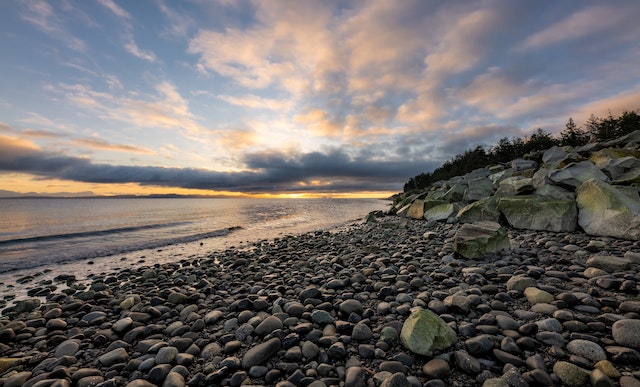
Why are some beaches rocky and some sandy? It is because of the energy of the sea, the source of the particles, the shape of the shoreline, local weather, and the angle of the seabed, amongst other things.
There is no agreement on how much coastline there is in the world. There are estimates of between 1.16 million km and 1.6 million km of coastline in the world. It is a constantly changing figure and the rising sea levels caused by climate change are altering the amount by changing the shape of the coast. Not all of the world’s coasts have beaches. There are many coasts that simply end in a cliff. Still, estimates on that coastline put 31% of it as sandy beaches. This was worked out by a team of researchers in the Netherlands who used machine learning to identify the sandy beaches from NASA’s satellite pictures in 2016. Africa has more sandy beaches than any other continent. So, why are some beaches rocky and some are sandy?
Wave energy may be one of the biggest reasons. There are two reasons for this. Firstly, if the sea has high energy, which means a high wave frequency, the smaller grains are more likely to be carried away from the beach, leaving the heavier pebbles and rocks. Sandy beaches are usually found in places that have low-energy seas. Sandy beaches are often found in bays, or areas where the sea is shallow because the seabed drops off slowly. A shallow sea dissipates the energy from the waves, making them weaker and less able to carry matter away. The second reason is that a lot of sand and rocks are carried out of the sea and the strength of the sea dictates what they can carry. Water with a lot of power can carry rocks and even boulders. As the energy in the water diminishes, the weight of the things it can carry drops until sand is the only particle the sea can carry. On shorter beaches with a steep seabed, the sea will still have a lot of energy and it will be able to carry rocks and pebbles up onto the beach. With a shallower sea and a longer seabed, the sea will drop the pebbles and rocks further out where it has energy, but it will have enough energy to carry sand up to the beach and drop it.
The source of the particles is another reason for the differences in beach. The rocks on rocky beaches usually come from cliffs that are very close by. If you have a beach with rocks or pebbles, you are very likely to find the cliffs where the rocks have come from. The wind, the rain, and repeated freezing and heating will weather the cliffs until pieces break off. These pieces roll down to the beach where they remain. The sea and the wind will slowly wash over them, eroding them until they are round and smooth. Sand may have come from further away because it takes a long time for the water to break the rocks down into sand. The source of a pebble beach may be the nearby cliffs, but the source of a sandy beach may be at the top of a mountain far inland.
Weather plays a big part as well because strong winds give the sea more energy and enable it to carry heavier things. There are probably more rocky beaches in locations that experience strong wind. This wind will also help to erode any cliffs that are close by.
The type of rock will also play a big part as well. Some rocks are less strong and are much easier to erode. Sand is usually made from quartz and feldspar. Harder rocks, like granite, don’t erode easily and will stay as rock for longer. The type of rock the sand came from will dictate its color. Light brown and yellow sand comes from feldspar. The black sand that Hawaii is famous for comes from volcanic rocks, such as basalt and hardened lava. White sand beaches, again in Hawaii, are not made from rock but actually come from parrotfish. They eat algae off rocks and dead corals, grind it up, and poop out what they don’t eat as sand. So, those beautiful white beaches are made from parrotfish poop. And this is what I learned today.
Photo by James Wheeler: https://www.pexels.com/photo/photo-of-rocky-shore-during-sunset-3774243/
Sources
https://education.nationalgeographic.org/resource/beach/
https://earthobservatory.nasa.gov/images/92507/taking-stock-of-the-worlds-sandy-beaches
https://wonderopolis.org/wonder/Where-Does-the-Sand-on-Beaches-Come-From
